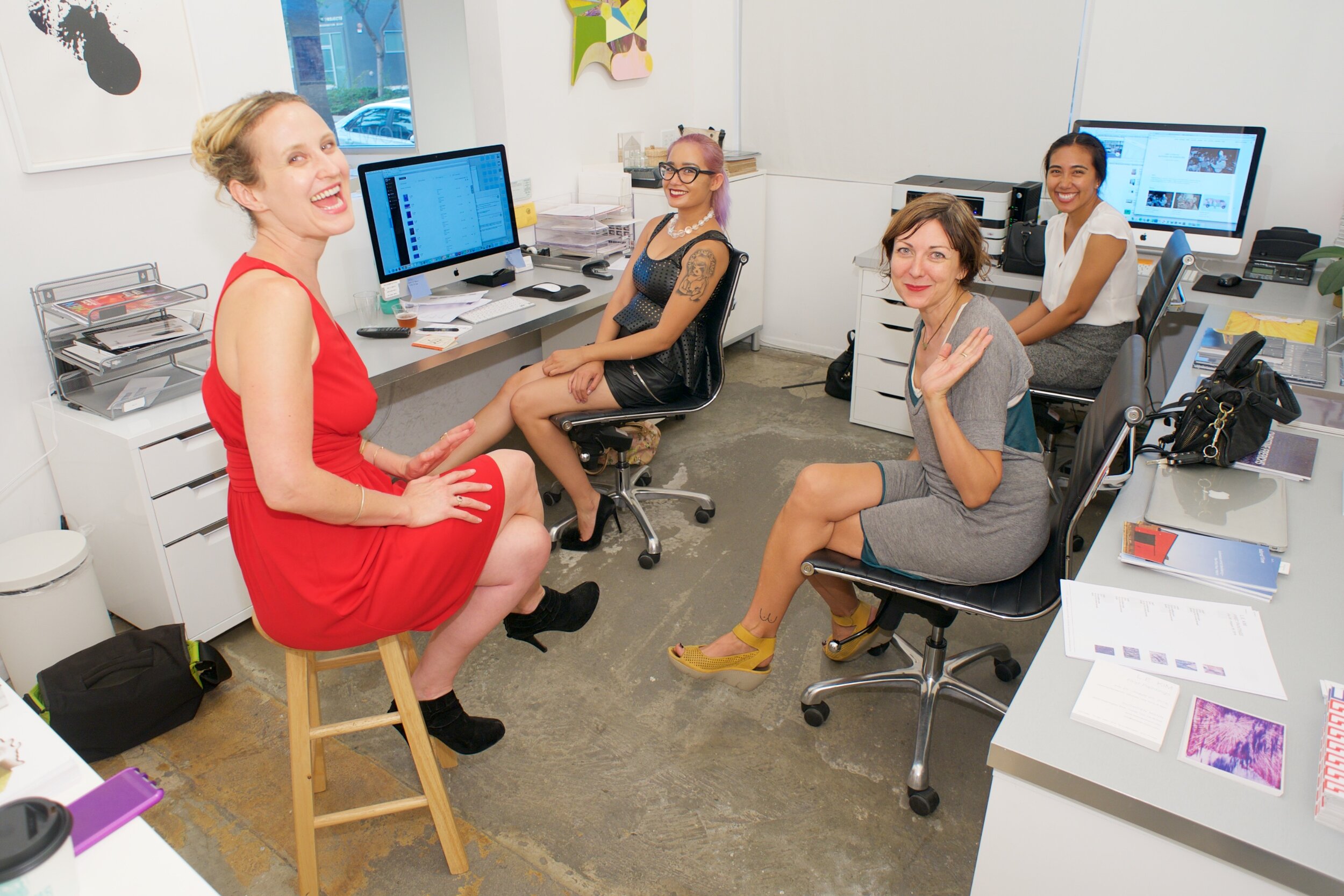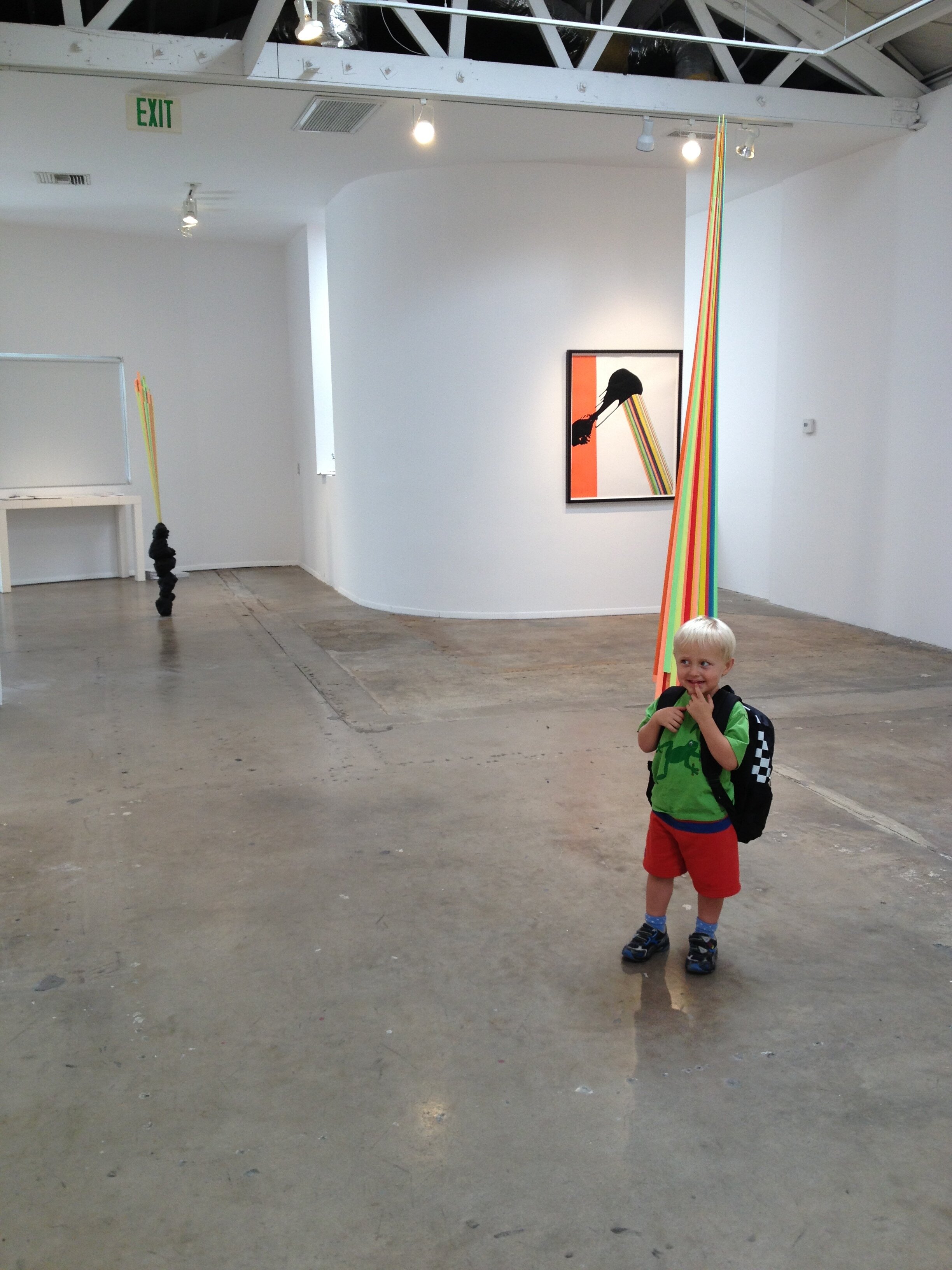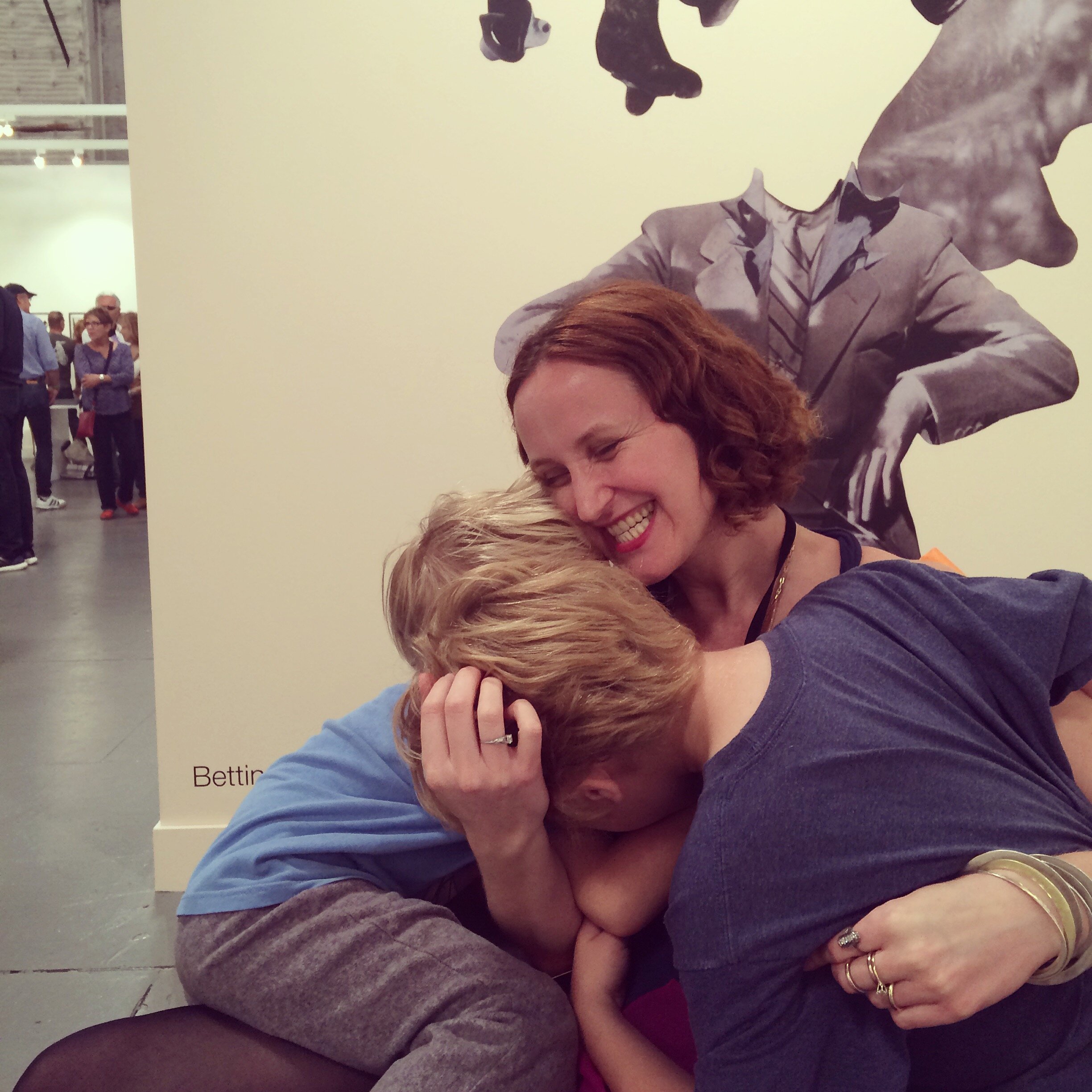Voices: Deb Klowden Mann, Los Angeles
Deb Klowden Mann
Deb Klowden Mann is Principal of Klowden Mann, located in Los Angeles.
Deb Klowden Mann and her sons on the gallery floor (2018) Courtesy of Deb Klowden Mann.
What are some common themes in your program?
I am most at home when I’m allowed to be fully in my intellect and fully in my emotions at once, and I am attracted to art that allows and provides space for both, while also forcing me to stretch into places that make me uncomfortable or even scared. I love multidisciplinary artists who are able to offer depth, seriousness and irreverence, all at the same time. I love artists who use beauty as a strategic mode of disarmament. I love work that makes me uneasy but that I can’t stop looking at. I love work that challenges existing power structures and asks us to question the languages we use to receive and to act in the world. I am also very committed to showing work that asks us to be in our bodies, to slow down, to provide space for the elements of our existence that our culture has such a hard time acknowledging or speaking to--the messiness, grief, humor, uncertainty, connection.
Most of my artists--but not all-- are consciously conceptually driven, and all of them are formally innovative and rigorously pushing themselves in all areas of their work. I’ve always made the choice to push my program so that there was clear coherence, but that the coherence was not overt according to style or any easily recognizable category --both because I want to challenge my artists and my audience, but also because it’s incredibly important to me that my artists have room to grow and change. A critic in LA who I love has told me for years that my tagline is “weirdness encouraged,” and she may well be right. But the truth is that I trust my artists, and I allow them a great deal of freedom within the space to fully articulate their visions for the work and to take real risks--not just work that feels acceptably risky by being non-commercial but academically safe, but work that scares them and that they really don’t know how people will respond.
What qualities do you look for in an artist?
When I am considering an artist for representation, there are so many factors to consider, and in the end more than anything I trust my gut. It’s very important to me that I feel confident that I believe in them and their voice and vision beyond the particular body of work that they are showing me, or the particular work that brought me to them. I am slower than the contemporary art world wants me to be in taking on new artists, but that is because I am not interested in allowing all the right boxes checked to decide on that relationship for me--it’s not about who is getting attention right now, or what the market wants, or who has been pre-validated for me by all the right schools and residencies. To me, it’s about believing in the long arc of what someone has to say in the world, and believing that I am the right person to help amplify their voice in an environment that often discourages complexity.
What is your personal or professional motto?
Generosity and kindness are integral components of strength, power, and vision, not detriments to them.
Rodrigo Valenzuela, Journeyman, 2020, install view, photo by Michael Underwood. Courtesy of Klowden Mann
Who is the artist in your program that you have worked with the longest? How did that relationship begin?
The two artists I’ve been lucky enough to work with the longest are Rebecca Farr and L.E. Kim, who are both extraordinary artists and wonderful friends, and have each acted as a compass for my direction with the gallery many times over the years. I was introduced to each of them by friends who know me and my interests well, and I remember each of those first meetings as offering great clarity into what I hoped the gallery would become. I remember my mother and I arriving at Rebecca and Lisa’s home months before the gallery opened with my youngest son, now ten, who was just weeks old at the time. She was so warm and engaging and her work was so clearly unafraid of speaking to history and emotion at once. And she’s just such a damn good painter. I felt lucky to ask her to open the gallery with our very first show that September, and that she said yes.
L.E. Kim and I met at the gallery for my very first studio visit after we had signed our first lease in 2010, months before we would actually open our doors. She had recently graduated from Cal Arts, and she showed me a video piece she had done there in which we looked at the night sky and could see that it was moving and shifting but so slowly it was hard to decipher what was happening. She had removed one star at a time, this small gesture of marking time and material that was only possible through the medium she had chosen, and it stuck with me in such a significant way. I knew in that moment I wanted to work with her. And she also became my guide to the LA art world in many ways--pulling me away after I got my three month old and two year old to bed to go to openings at Human Resources, to delve into the conversation in LA at this moment when we could all feel that more attention was beginning to be paid to our community, and the question of maintaining the freedom of experimentation that had always defined LA once that attention arrived was on all of our minds, even if we weren’t always speaking it.
Gallery Director Tyler Park with artist L.E. Kim in front of Andrea Chung’s work at her opening in 2019
Tell us about one show you are excited to present in your gallery this spring.
I’m very excited about Jamison Carter’s solo show, which was originally scheduled to open this month and is now on hold until we are able to physically be in the space. I’ve felt very fortunate to watch and participate in Jamison’s development as an artist over the last seven years, and he is definitely an artist who--even after all of that time--still has the capacity to surprise me. This new body of work integrates so many of the themes he has been exploring since long before the two of us were working together, and yet formally it is unlike anything I would have expected. As always, he bends the relationship between two and three dimensional work, but the incorporation of highly detailed drawing transferred onto cast resin is unexpected and powerful in ways I hadn’t anticipated.
Deb Klowden Mann with staff Daphne Mangin, Nancy Garcia and artist Bettina Hubby, 2016
What is it about artists that you respect and honor the most?
Artists are and always have been my people, and I feel so lucky to constantly be surrounded by the desire to both see and change the world that I feel they so often embody. I believe that artists all kinds (visual artists, dancers, musicians) are our material philosophers and the only people who can both show us the beauty of the world as it is, while also forcing us to question the way we move and act in the world and challenge us to do better, and show us that change is possible. We are built to need to see what is possible before we can enact it, and artists make that possible. As one of my best friends often says, it matters the stories we tell.
Who was the first artist you ever worked with? Tell us a bit about that story.
The first artist I ever worked with was my Mom, Patricia Doede Klowden! Growing up she was always making work, taking classes, and providing me the opportunities to do the same. Then when I was 13 we lost my uncle, her younger brother, and in dealing with her grief painting took on a different meaning and urgency in her life (and in mine). My father was often traveling for work and my brother was already in college, so often it was the two of us, and I remember evenings where after dinner she would be in her studio painting with her hands and carving out space for herself and what she needed to feel and process. I remember doing my homework in the room next door, or my favorite spot which was inexplicably the stairs, and taking breaks joining her in the studio, or looking at the work together. What she made offered me a new and incredibly important way to understand her as a person, but also showed me the way that making art could create additional space in the world, and that was such a foundational lesson for me in everything I have worked towards in my life personally and professionally.
Name an artist you don't represent that are particularly drawn to and why.
I have always loved Iva Gueorguieva’s work. Iva is a Bulgarian-born Los Angeles-based artist, and the integration of material deliciousness, abstraction with representational elements, deep complexity of ideas and instinct, and moments of humor are all things she brings across each body of work.
Jamison Carter, Hallelujah Anyway, 2018, install view, photo by Lee Thompson. Courtesy of Klowden Mann.
Who was the last artist who’s studio you visited? Tell us a bit about the work.
Ack it’s so strange to realize that my last in-person studio visit at this point would have been back in February, and early on in the month even before our fair schedule became intense… Honestly, it’s been years since I’ve gone that long without being in someone’s studio, and I miss it hugely. One of the artists I visited last was an artist I represent and a dear friend, Jonesy. He is in a stage of experimentation for a new body of work that pushes the physicality of queer narratives at a moment when the question of physicality and the categories that many of us in the queer community grew up with are now being disentangled and redefined. The film stills he showed me captured a feeling of film noir narrative nostalgia along with the hope for new narratives in this expanded community. The work is still in early germination phases so I don’t want to overly define Jonesy’s intention yet, but those feelings are where the images took me.
Why are you passionate about art?
I’m passionate about art because I believe art in any medium has transformative power—it offers experience outside of the linear narrative that dominates most of our daily lives, and in so doing it powerfully enhances our ability to imagine realities different than those in which we live. I’m also passionate about it because it ignites feeling in me more than anything else ever has (other than the love of human beings). It helps me connect with all of the time I got to spend with my mother in museums when I was a child, listening to her point out specific brushstrokes, subject matter, what pieces spoke to her; later on watching her paint abstracts and landscapes with her hands, and getting lost in my own paintings when I made my own work. It helps me understand history in a visceral way that I bring to everything else I do.
What does the art world need more? Less of?
The art world needs an ecosystem that supports new galleries, and accordingly new artists. As it is now, it is very, very difficult to survive the first 3-5 years of running a gallery without some measure of financial support. Far too many galleries with extraordinary potential close because they can’t make it past a period of a few months in which sales are scarce, and those periods are frequent in the first years of a gallery, even for those dealers opening spaces who are already well-connected--and even more so in this moment of economic uncertainty. I would love to see a $10,000 to $50,000 unrestricted grant that supports new commercial spaces, especially those being opened by people of color who are statistically much less likely to have access to the kind of generational wealth that helps sustain a new gallery past the early years.
(left) Jamison Carter, White Light from Dark Matter, 2013
(right) Deb at Paris Photo LA with her boys, 2015 in front of Bettina Hubby’s work. Courtesy of Deb Klowden Mann
How have you grown as a dealer over the years?
Coming from a more academic frame of mind, it took me some years to truly let myself be comfortable with how much I love selling art. Once I recognized how much I loved and believed in it, it became much easier to attract the kind of collectors I most want to work with. I was better able to serve my artists’ visions beyond the life of a specific exhibition by connecting their work with people or institutions who would value their voices longterm. It helped me to recognize the significant role collectors have played historically in amplifying the voices of those they believed in, and begin to feel how extraordinarily lucky I am to connect my artists with that kind of support.
How have you grown as a curator over the years?
I’ve learned to trust my vision, and in so doing I’ve (maybe paradoxically) become more open to being wrong, to being surprised, and I’ve become less and less influenced by the way things “should” be done.
Bernard Chadwick, I Dream of You opening reception, 2016, photo by Steven Rimlinger
Name a big overall lesson you've learned in running a gallery.
I have learned to become very resilient, and I am very grateful for that. An art dealer has to be willing to manage great expectations and sometimes great disappointments, to be open to learning from public and private mistakes, to know that many people won’t agree with their vision, and to hold on as best as they can to what they believe in, even when times are lean. All of that makes the successes even more strongly felt when all the work and longterm strategies begin to pay off. The recognition that my work has impacted many lives keeps me going even in the tough times. And of course, the core of it all is my belief in my artists.
What are you busy working on right now?
Ahhhh so many things! I am working on a project with my brilliant friend and curator jill moniz that I'm very excited about, and I am also writing a book about Endometriosis, chronic illness and feminism in what I used to call 'the digital age of pre-apocalyptic enlightenment,' but now need to re-examine now that we are in the midst of a kind of apocalypse moment. I've also been doing some podcasts with Michael Shaw on the Conversation, which is such a joy to get to do again (I first started as an occasional co-host back in 2014). I tend to enjoy having multiple projects going at once. It keeps me feeling full, and always excited about what is coming next. (Also exhausted, but that’s another story… )
What is the most important quality you look for in a patron of the gallery and your artists?
I look for people who are willing to do the hard work of using their own eyes and minds to decide what they believe in, and what has value. It’s terrifying not to let yourself be led by the opinion of those who surround you (or even the selective opinion of key individuals). I’m not saying don’t do your homework—I think understanding curatorial and commercial context is always a good idea. But I believe strongly in the value of following your gut and taking risks. The possibilities that you might fail spectacularly are certainly more likely. And of course, so are the possibilities that you might succeed spectacularly.
Install view, Sarah Cromarty, Wishful Thinkin’, 2018. Courtesy of Michael Underwood and Klowden Mann.









